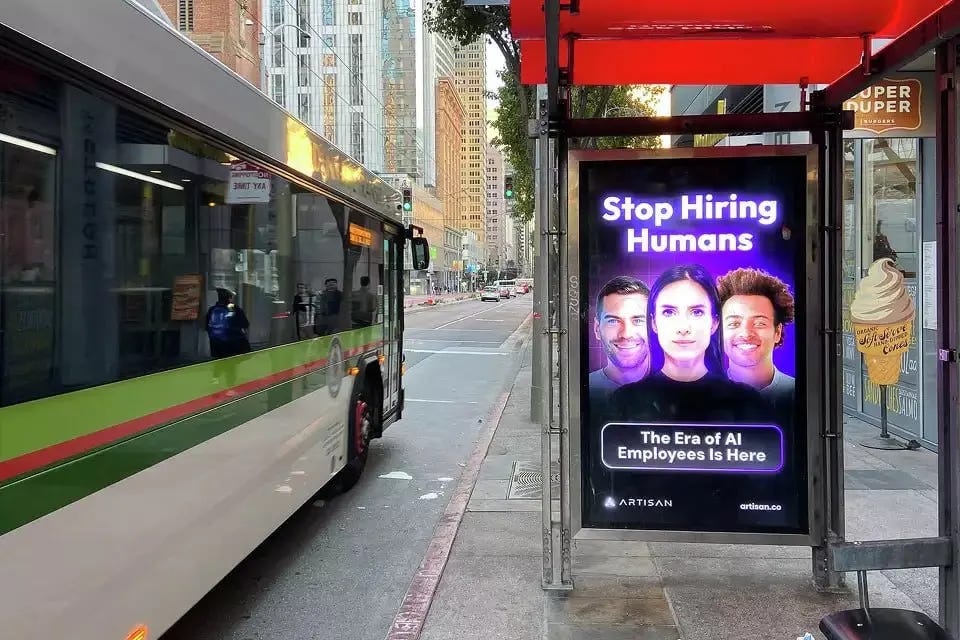The AI disconnect between expectations and actual use cases
CEOs and employees aren't on the same page.
AI startup Artisan caught the attention of San Francisco (and tech publications) with its billboard campaign. The tagline read: Stop Hiring Humans.
Artisan's product is an AI sales agent (named "Ava") that researches leads, sends outbound messages, and can “engage [with] interested prospects — just like a human would."
The backlash was, understandably, fierce. In a blog post, CEO Jasper Carmichael-Jack shared some screenshots from inbound messages and social media, ranging from "You should be ashamed of yourselves" to death threats. Carmichael-Jack wrote, "We didn’t expect people to get so mad. The goal of the campaign was always to rage bait, but we never expected the level of backlash we ended up seeing."
But while people were furious, investors came calling. Artisan announced $25 million in venture capital funding in April 2025. Clearly, investors believe there is a market for an AI sales agent that can replace the work of humans.
How can a product that infuriates people also find its place in the world? The answer is a disconnect between what executives want AI to do, its actual capabilities, and how employees incorporate AI into their everyday work.
Very few people understand good AI usage
In an article for Every, AI consultant Alex Duffy wrote, "Executives want AI adoption but struggle to differentiate value from noise, managers are unsure how to evaluate AI-powered work, and individual contributors feel paralyzed by the gap between AI's potential and their current comfort level."
Part of this is because tech companies are rushing to add AI to their products without thinking about the practical application of such capabilities. For example, a product I use daily added an "AI assistant." I struggled to see how I would actually use the AI assistant in my everyday work. I sat in on an hour-long live demonstration and still had no clue.
I consider myself pretty tech-savvy, but the AI capabilities didn't seem to match any use case I could think of. I could chat with an AI bot within the product and ask it questions about my data. But this wasn't faster than creating a report, and I couldn't trust that the response was accurate.
Perhaps it will improve in the future. Or perhaps use cases don't exist. Duffy added, "Even the people most excited about this shift—your CEO included—are figuring out what good usage looks like in real time."
Shopify CEO Tobi Lutke recently wrote a memo to employees (posted on X) that "before asking for more headcount and resources, teams must demonstrate why they cannot get what they want done using AI." Lutke also wrote that "using AI well is a skill that needs to be carefully learned by... using it a lot."
Therein lies the rub, since use cases often aren't obvious and require a ton of time tinkering with prompts and output. In my example, could I find appropriate use cases if I kept trying? Maybe, but it could require a ton of time (and thought) to figure out what works and what doesn't.
Many AI capabilities have the same quandary: vast, non-specific use cases make it hard to see the possibilities. People don't have the skills necessary to narrow the broad range of capabilities into everyday work.
And is Shopify planning to give employees time within their workday to tinker? Or are people expected to learn on their own? In his directive, Lutke outlined that AI usage questions will be added to performance reviews...
AI is not a magic solution
Lutke, like many executives, believes that AI is a multiplier. Artisan's product, Ava, promises to increase leads (certainly increase volume).
I've written previously that AI is overhyped (in its current form). To be clear: I use AI in various parts of my work. Sometimes it saves me time. Sometimes it's a "sparring partner" that can help me work out an idea I have in my head. Sometimes it does things I could not have done myself, like image generation or analyzing a large dataset in seconds. (Disclosure: the large dataset — some of my LinkedIn data — did not need precise results. If it had, I wouldn't have trusted AI with the task.)
I have not, personally, 10x'd anything. Because AI still requires thoughtful consideration and oversight of any volume it produces.
The other day, I received an email that was clearly written by AI. The exact type of outreach that "Ava" and similar products purport to improve. It was "personalized" with information scraped from either my website or LinkedIn. A combination of lines like "Your journey from a 15-year fintech career to supporting solopreneurs with content that enhances workflows is genuinely impressive" made it clear that it was written by AI.
My reaction? Report spam and block the sender. If someone can't be bothered to take the time to write an email, why should I be bothered to take it seriously?
CEOs should ask themselves: Is 10x really what we want? What if the 10x negatively impacts the business in other ways?
The cold email I received might have worked if a human had intervened and rewritten it — using AI as a starting point and not a destination. But that goes against the 10x mentality and seeing AI as a supplement, not a replacement. CEOs are likely thinking that AI can reduce headcount (or at least keep it flat). Volume coupled with a lack of training will lead to a whole pile of AI garbage, the exact opposite of anything productive or useful.
What's ironic to me is that some employees have been asking for technology to do their jobs better for years. When I worked for employers, I often begged for the products and budget to implement something that would get work done faster or more efficiently. Leadership looked at technology as a "hard cost" that would be an added line item in the budget, on top of employee salaries. They couldn't figure out that the time saved meant time those employees could spend doing something else.
Suddenly, with AI, they've changed their tunes. (Thanks, AI hype.) But the disconnect between expectations and actual use cases is widening.
If a person has spent their entire life walking, you don't hand them the keys to the car and say, "This will get you to your destination 10x faster. Now, go get on the highway."
Most issues of this publication are free because I love sharing ideas and connecting with others about the future of work. If you want to support me as a writer, you can buy me a coffee.
If you love this newsletter and look forward to reading it every week, please consider forwarding it to a friend or becoming a subscriber.
Have a work story you’d like to share? Please reach out using this form. I can retell your story while protecting your identity, share a guest post, or conduct an interview.





